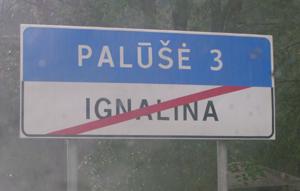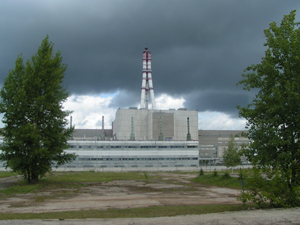Lithuania on collision course with EBRD over dismantling of Ignalina
on
Lithuania on collision course with EBRD over dismantling of Ignalina
Lithuania is following a two-track nuclear energy policy: it is decommissioning the closed-down Ignalina nuclear power plant and wants to build a new nuclear plant at Visaginas. Despite having recently selected GE-Hitachi as "strategic investor" for Visaginas, it is still far from certain whether this project will ever be realised. But the decommissioning project has also run into major problems. The Lithuanian government has come into sharp conflict with the European Bank for Reconstruction and Development (EBRD), which administers the decommissioning fund, about how to dismantle the plant. In addition, the project is facing a financing gap of €1.5 billion after 2014.
 |
| Farewell, Ignalina (photo: Jan Haverkamp) |
‘We are a nuclear community’, Lithuania's Federal Minister of Energy, Arvydas Sekmokas, recently proclaimed to a group of foreign journalists on a visit to Vilnius. According to Sekmokas, even the disaster at Fukushima did not significantly dent popular and parliamentarian support for the government’s plan to have a new nuclear power plant built by 2018. He cited several opinion polls showing that the Lithuanian people still mourn the loss of Ignalina, the Soviet-built nuclear plant that was shut down at the end of 2009 as a condition for Lithuania’s accession to the EU. Ignalina had been the country’s ticket to energy independence; since its closure Lithuania has become dependent on Russian gas and energy prices have gone up.
So is Sekmokas correct that the Lithuanian people still support nuclear power after Fukushima? According to a recent survey from the University of Technology in Kaunas, public support for a new nuclear power plant in Lithuania dropped from 60% to 10% after Fukushima. By contrast, the government claims that Fukushima led only to drop of support from 75% to 60%. However, the government seems to base this figure on the average of several opinion polls held since 2007. Between February and June 2011 the proportion of Lithuanians who “evaluated the use of nuclear energy positively” had according to these polls dropped from 58 to 44%. Very important in this regard is the attitude of the popular President Dalia Grybauskaite, Lithuania’s “Iron Lady”, who has expressed her support for the Visaginas project.
Unemployment rate
However the story of Visaginas may end (for more information see the box at the end of this article), at this very same time another nuclear drama is unfolding in Lithuania, which is getting a lot less attention. This revolves around the decomissioning of Ignalina.
When the second Ignalina reactor was taken off the grid at the end of 2009 (operations at the first one had been shut down at the end of 2004), from one day to the next Lithuania went from being a major
| Very important in this regard is the attitude of the popular President Dalia Grybauskaite, Lithuania's "Iron Lady", who has expressed her support for the Visaginas project |
However, the Lithuanians have resigned themselves to their EU-imposed fate and have dedicated themselves to the decommissioning of Ignalina. At first glance, the decommissioning of nuclear power plants may seem much a less interesting affair than the building of new ones, but with growing numbers of nuclear power plants in Europe reaching the end of their lifetimes in the coming decades, decommissioning is bound to become an increasingly big issue. The European Commission estimates that approximately one third of the 145 power reactors currently operating in the European Union will need to be shut down by 2025. Experience gained so far (relatively few large-scale nuclear plants have as yet been dismantled) shows that the costs will be very large. For example, in France the decommissioning of the small 70 MW Brennilis Nuclear Power Plant cost €480 million. The current estimate by the United Kingdom's Nuclear Decommissioning Authority is that it will cost at least £70 billion to decommission the 19 existing nuclear sites in the UK.
Or, to put a more positive spin on it: decommissioning is bound to become a thriving business in the coming years. Indeed, this is exactly how the Lithuanian government looks at it. Lithuania’s Ministry of Energy views the dismantling of Ignalina as an opportunity to gain a wealth of expertise that other countries will find interesting. The Ignalina project is the first Soviet-style RBMK-reactor ever to be dismantled in the world (not counting the one at Chernobyl). It will serve as a model for reactors of the same type and for other types of reactors as well.
Dissatisfied
Unfortunately, the dismantling of Ignalina, which is supposed to return to “brown field” conditions in 2030, is not at all going smoothly. The first phase, which started at the end of 2004, is already three to
| 'We are dissatisfied with the bank and the agreement. It is insufficient in financial terms. And the EBRD waters down responsibility. It shows no responsibility' |
The conflict seems to be essentially about who should be in charge of the process. It seems to have started when the conservative Homeland Union–Lithuanian Christian Democrats of Andrius Kubilius took power at the end of 2008. The new government felt that Lithuania was not treated as an equal partner. Ignalina’s Director of Corporate Affairs Osvaldas Èiukšys, an experienced diplomat, says that the agreements with the EBRD were appropriate for a non-EU Member State, but not for a member of the EU. ‘We are dissatisfied with the bank and the agreement’, Èiukšys says bluntly. ‘It is insufficient in financial terms. And the EBRD waters down responsibility. It shows no responsibility.’
The EBRD is reluctant to say much about the conflict. The London-based bank manages the International Ignalina Decommissioning Support Fund (IIDSF), which is financed by the EBRD, the EU and 15 donor countries. IIDSF has funded the construction of a 450 Megawatt gas-fired power plant in Lithuania and is paying for two decommissioning projects in Ignalina: the construction of a spent fuel storage facility and a radioactive waste treatment facility. In comments to EER, the EBRD said that the two decommissioning projects ‘have experienced problems for a variety of reasons, some technical, most commercial in nature’. It also said that ‘Ignalina’s new management, mostly recruited from outside the nuclear sector, has decided to deal with the issues at hand on their own without involving the bank’. This apparently refers to the change in the administration of the project after the new Lithuanian government took things in hand.
Own show
 |
| Ignalina nuclear power plant, Lithuania (photo: Jan Haverkamp) |
For Èiukšys the solution is clear: ‘Leave management of the IIDSF to us. We know best how the money can be used most effectively.’ And he has the support of the Minister of Energy Sekmokas: ‘We want to manage the plant ourselves’, Sekmokas says. EBRD does not want to respond to this demand, except for saying that ‘the bank is very concerned and the resolution of the difficulties is taking much longer than was anticipated’.
Independent experts in Lithuania are critical of the government’s position. Professor Jurgis Vilemas, who was the Director of the Lithuanian Energy Institute until 2004, Chairman of the Institute’s Scientific Council until 2010 and Chief Researcher until very recently (23 August), said to EER: ‘Before the EU-accession in 2004, Lithuania listened and followed the advice it got. After the accession the strategy is: We run our own show.’
Vilemas says that in the Ignalina project ‘all professionals were replaced by people from the outside; they talk about mismanagement to cover up their intention to fire people from earlier times’. According to Vilemas, the EBRD should keep control of the project. ‘The party that is providing the funds should - and must - also be in control’.
Drop tests
The conflict with the EBRD is not the only battle Osvaldas Èiukšys is fighting. He also has a quarrel with GNS (Gesellschaft für Nuklear Service), the German company that is responsible for transporting the radioactive material from the water tanks at Ignalina and storing it at the spent fuel storage facility. This facility is located just a few hundred metres away from the plant and currently being built. GNS, specialised in radioactive waste disposal, is a joint-venture of the four major German energy companies Eon, RWE, ENBW and Vattenfall.
Ignalina’s management is critical of the quality of the casks that are meant to be used for the transport and storage of the radioactive waste. The Lithuanians claim that the casks have not been sufficiently tested and they want drop tests to be carried out. Èiukšys says the casks are ‘rubbish and dangerous’.
GNS, however, does not see any safety flaws. In a statement to EER the company declared that the
| 'The bank is very concerned and the resolution of the difficulties is taking much longer than was anticipated' |
The conflict means that the fuel rods of the first Ignalina reactor, which should have been moved to the storage facility, are still awaiting transport. As long as the pools of Ignalina 1 have not been emptied, reactor 2 cannot be unloaded either. This is further delaying the decommissioning process. According to Professor Vilemas, ‘both sides are responsible for the delay: mistakes have been made by everyone involved.’
No legacy
By now construction on the spent fuel storage facility is three to four years behind schedule. The hope is that it can go into operation in 2012. The government continues to cling to its ‘immediate dismantling’ strategy. In its mind, the entire plant should be dismantled without delay. It wants to make use of the existing workforce and operational infrastructure. This will be the least costly option and ‘leave no legacy for future generations’.
The latter is not entirely accurate. The spent fuel storage facility on the premises is planned to remain operational for 50 years. What will happen to the radioactive waste after that is still unclear. The original
| 'Before the EU-accession in 2004, Lithuania listened and followed the advice it got. After the accession the strategy is: We run our own show' |
If by 2029 all that remains of Ignalina is a ‘brown field’, the decommissioning of the first RBMK reactor will have cost €2.9 billion, based on today’s calculations. This is about as much as the cost of a new nuclear power plant. At the end of this year some €700 million will have been spent. Of the remaining €2.2 billion, some €1.5 billion has not yet been secured. The money is not likely to be forthcoming unless the government in Vilnius, the EU and the EBRD find common ground.
|
Visaginas to be built by Hitachi-GE … perhaps On 14 July Hitachi-GE Nuclear Energy was selected as the “Strategic Investor” for the Visaginas Nuclear Power Plant Project planned by the Republic of Lithuania. The Japanese-US combination beat the US Westinghouse Electric Company which had also been in the race. ‘Strategic investor’ means that the company has ‘preferential negotiating rights for investment on the project, concession agreement and other contracts including the EPC [engineering, procurement and construction] contract’, according to the press release from GE-Hitachi. In other words, GE-Hitachi has not yet committed any money nor has a definite contract been signed. |
|
More information For earlier stories in European Energy Review on the Baltic energy market, see: Russia proposes 'electricity pipeline' to Germany |


Discussion (0 comments)